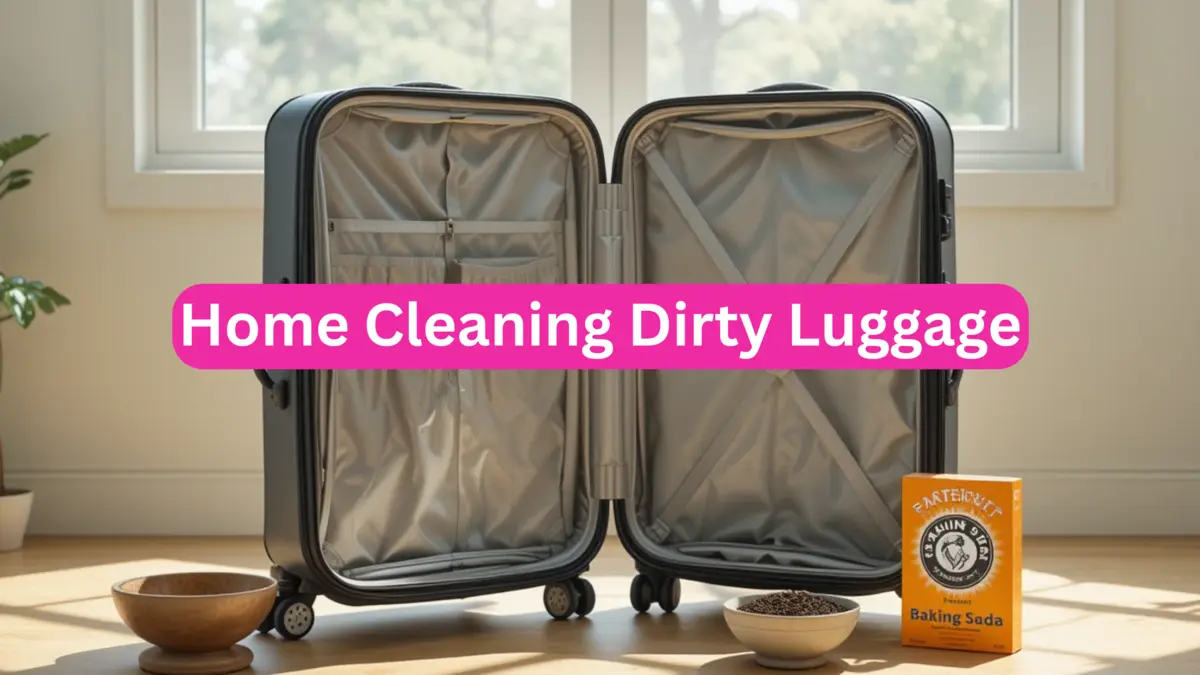After a long trip, your suitcase might be carrying more than just souvenirs – think dust from the airport floor or spills from on-the-go snacks. Giving your luggage a good cleanup at home not only keeps it looking great, but also makes sure you’re not packing away last month’s dirt or germs. But if someone don’t know how to clean dirty luggage then it is important to have a complete luggage cleaning guide with you.
We all love starting a new adventure with fresh-smelling gear, right? A little effort to clean your bag will pay off in a nicer journey next time. In this article we will tell you how to clean luggage bag at home with step by step cleaning process.
Thing to Take Care before Cleaning:
Start by removing all items from every compartment and pocket. Check for stray bits like receipts, coins, or that missing earring hiding in a zipper pocket. If any clothes or packing cubes are dirty or wrinkled, toss them straight into the laundry; it’s nice to have a freshly laundered wardrobe next time, after all.
Set your empty bag in a well-lit area (a bathroom or laundry room is ideal) so you can see stains or debris clearly. Before any wet cleaning, give the interior a thorough vacuum. Use the brush or crevice tool to vacuum out crumbs, sand, or pet hair from corners and folds. This makes the rest of your cleaning a breeze and prevents loose dirt from spreading around when it gets wet
How to Clean Luggage At Home? Step-By-Step-Guide
1. Identify the Material:
You will follow the cleaning process depending on the material of your luggage.
- Fabric (Soft-Sided) – Most soft low price luggage is made of cloth materials like nylon, canvas, or polyester. These bags feel flexible and often have exterior pockets or straps. If it looks like strong cloth, it’s fabric.
- Hardshell (Hard-Sided) – Hardshell Luggage have a rigid outer shell made of polycarbonate, ABS plastic, aluminum, or similar materials. They hold their shape even when empty, and often snap or click shut. These are great for impact protection but can show scuffs easily.
- Leather – Leather suitcases (genuine or faux) have that classic rich leather look and feel. The surface is smooth and often a polished tan or black. Leather needs gentler care (and occasional conditioning) because it can dry out or crack if mistreated.
Knowing the type of your bag helps you pick the right cleaning method so you don’t damage it.
2. What You’ll Need:
- Soft cloths or sponges – for wiping surfaces gently
- Warm water and mild soap – dishwashing liquid or a gentle laundry detergent work well
- Bucket or bowl – to mix your cleaning solution
- Soft brush or old toothbrush – handy for scrubbing wheels, seams, and any stubborn spots
- Vacuum cleaner (with attachments) – to suck up crumbs, sand, and dust inside the bag
- Disinfectant wipes or spray (optional) – useful for handles and wheels
- Baking soda or coffee grounds – great natural deodorizers if your luggage needs a scent-refresh
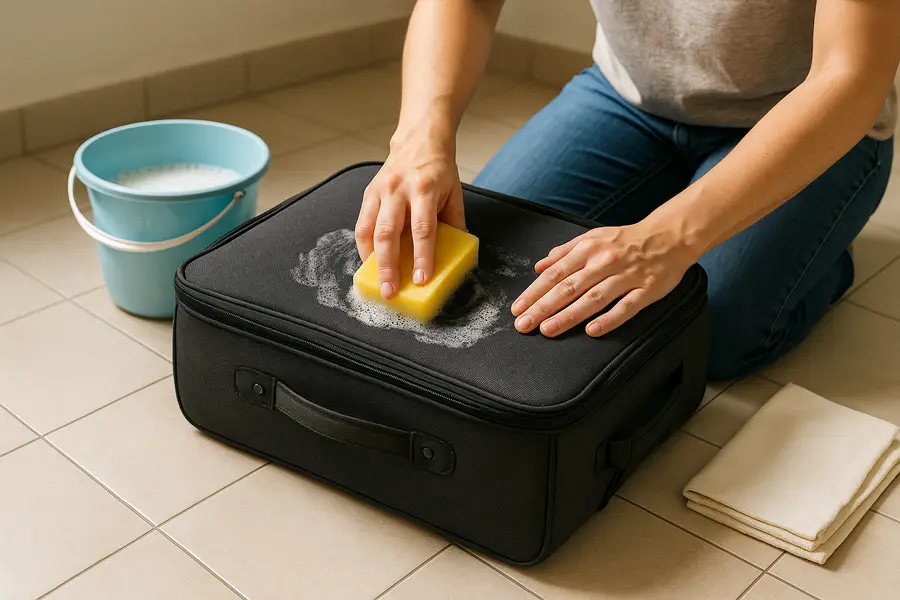
3. Clean the Exterior:
Now tackle the outside of the bag, which depends on its shell material:
Fabric Luggage:
To clean dirty fabric luggage or soft sided suitcase (cloth exteriors), use a gentle soap solution. Fill a bucket with warm water and a squirt of dish soap or mild detergent. Dip a sponge or soft cloth in the soapy water and wring it out. Wipe the entire exterior surface, scrubbing lightly to loosen dirt. Rinse the cloth often in clean water and wipe away soap residue.
- Stains: For small spots, you can make a paste of baking soda and water, apply it to the stain, let sit 10–15 minutes, then brush off. (Martha Stewart’s team suggests sprinkling baking soda on oil stains and vacuuming it off after 15 minutes.) You can also spray or wipe a mixture of equal parts white vinegar and water on stains – vinegar is a mild disinfectant and brightener After spot-treating, dab with a clean damp cloth.
- Dry: Let the fabric surface air dry completely before packing it away. Avoid machine-drying or intense heat.
Hardshell Luggage:
To clean hard-shell luggage, cleaning is usually easier. Wipe the case with a cloth or sponge dipped in warm water mixed with a little mild detergent. Be gentle to avoid scratching the plastic or metal shell. For tough spots: make a paste of baking soda and water, rub it on the mark, and wipe clean. You can also try a melamine foam “Magic Eraser” for stubborn scuffs, but test it on a small area first.
- Rinse & Dry: Rinse off any soap or paste with a damp cloth, then dry the shell thoroughly with a towel. Standing it upright in a well-ventilated spot until fully dry is best. This prevents water spots or streaks.
- Scuffs: Light scuff marks on plastic can often be buffed out with a little non-gel toothpaste on a soft cloth. Gently rub the toothpaste into the mark and then wipe clean.
Leather Luggage:
To clean a leather luggage it is important to know that leather needs the most delicate touch. First, wipe off any surface dust with a dry microfiber cloth or soft brush. Do not saturate leather with water. Instead, apply a small amount of leather-specific cleaner to a slightly damp cloth, then gently wipe the leather in circular motions. Focus on soiled areas but don’t scrub hard.
- Condition: Once the leather is clean and completely dry, apply a leather conditioner or cream. Rub it in with a soft cloth (especially on seams and handles) to restore oils and suppleness. Let it absorb for 10–15 minutes, then buff off any excess.
- Avoid Heat: Keep leather out of direct sunlight while cleaning and drying, as sun can fade or dry it out. A cool, shaded area is ideal.
Leather carry on suitcases benefit from this gentle treatment to prevent cracks or stiffness. After conditioning, a leather sealant (or a light coat of beeswax) can also protect the surface, but always test any product on a hidden spot first.
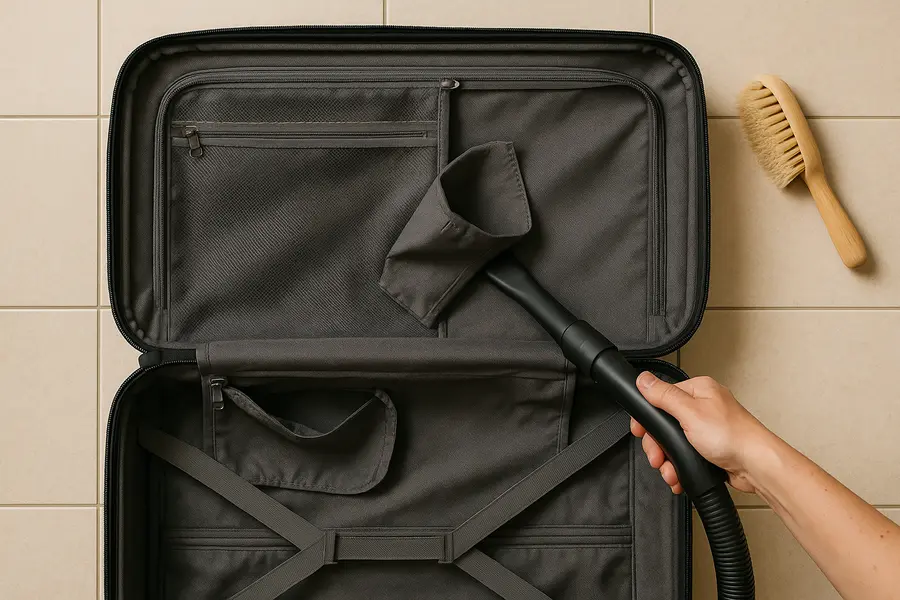
4. Clean the Interior:
Now for the inside of the luggage bag:
- Vacuum first. Using vacume will be best option if you want to clean your luggage without washing. With the bag fully open, vacuum every nook and cranny inside. Use a brush attachment to lift debris from pockets and seams. Make sure to get under flaps and into corners.
- Spot-clean stains. If there are spills or stains on the lining or pockets, wipe them with a cloth dipped in warm, soapy water. For fabric linings, a drop of laundry detergent in water works. Another option is a 50/50 mix of rubbing alcohol and water – adding a bit of lemon juice can help with odors. Gently dab or scrub the stained area, then wipe with a clean damp cloth to remove soap. Avoid soaking the lining.
- Remove odors: To banish any musty smells, sprinkle baking soda liberally on the interior fabric and let it sit overnight (or at least several hours). Baking soda absorbs odors naturally. In the morning, vacuum all the powder out. Alternatively, place an open box of baking soda or some activated charcoal inside the closed empty suitcase for a day to neutralize smells.
After cleaning spots, leave the luggage open in a dry, ventilated area until it’s completely air-dried. This prevents mildew or a trapped damp smell. If your bag has removable fabric liners, those can often be hand-washed gently or machine-washed on a delicate cycle, then air-dried before putting back.
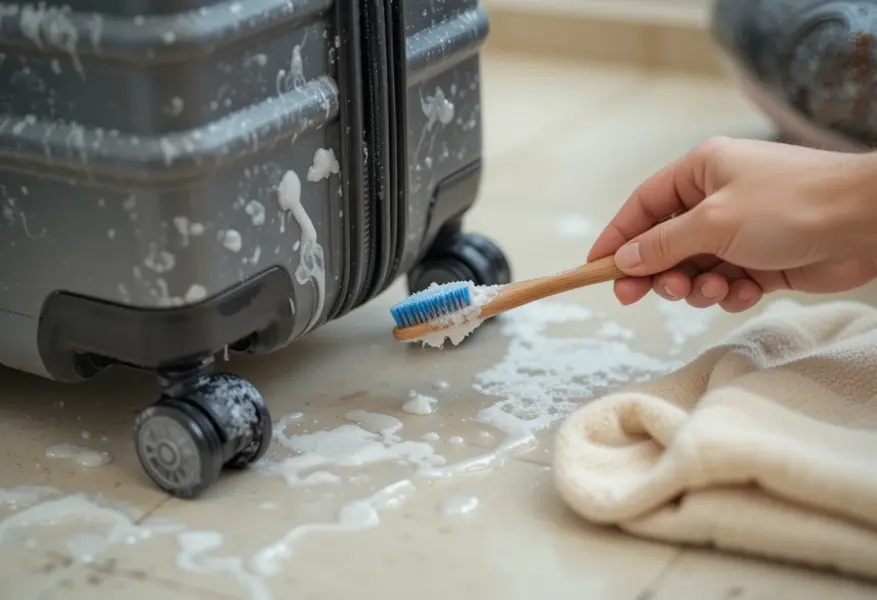
5. Clean the Wheels, Zippers & Handles
These small parts make a big difference in how your bag feels:
Wheels:
The suitcase wheels drag through dirt and grit on every trip. So to clean luggage wheels scrub them with a stiff brush (even an old toothbrush) and soapy water to knock off grime. Rotate the wheels as you clean so you hit all sides. Rinse with clean water and wipe dry. If the wheels wobble, tighten any screws. For a deeper clean, you can remove wheels with a screwdriver, clean them fully, then reattach.
Zippers:
Clean the zipper is importent otherwise you might face bag zipper problems. Clean zipper tracks by wiping them with a damp cloth. If teeth are sticking, lubricate lightly. A travel hack: rub a bit of beeswax, paraffin candle wax, or even a clean bar of soap along the zipper teeth to help it glide. In a pinch, lip balm or petroleum jelly (applied sparingly) can also work. Then zip and unzip a few times to distribute the lubricant. This keeps zippers smooth and prevents snags.
Handles/Grips:
Handles can be germ hotspots. Wipe them down first with a gentle soap solution, then finish by killing any lurking germs. Use an alcohol-based disinfectant wipe or spray on the pull handles and side grips. According to hygiene experts, “whatever parts you touch with your hands are by far the most important to clean and disinfect”. Let the disinfectant sit for the recommended time (usually 30–60 seconds) before wiping it off. This step ensures you’re not carrying germs home from the airport or hotel.
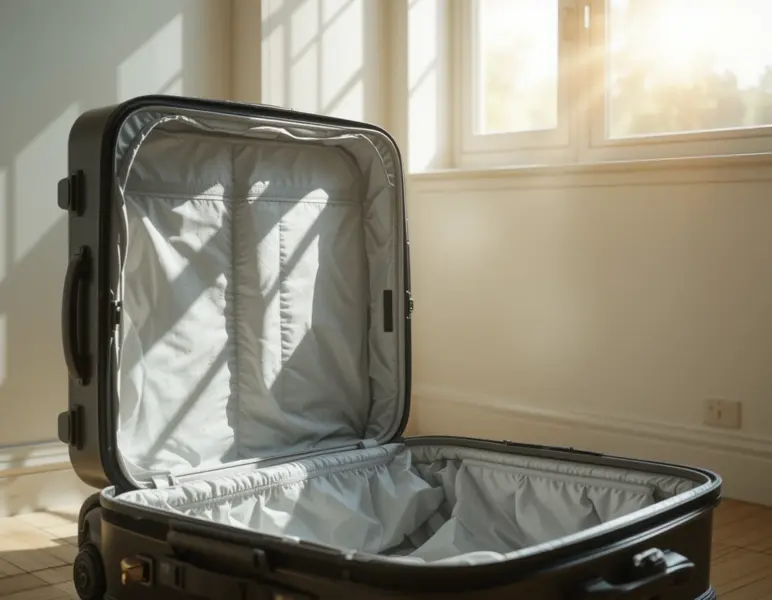
6. Deodorize and dry your luggage:
Now it’s time to let everything dry and add some freshness. Open your bag fully and, if possible, stand it up or lay it open in a dry, ventilated spot. Sunlight helps dry and can even reduce germs, but if you can’t go outside, indoor airing works too. Keep all zippers and flaps open to let air circulate. Drying may take a few hours – be patient, as storing a damp suitcase can lead to mildew.
Drying fully prevents odors and keeps mildew and mold at bay.
If you notice any lingering smells, sprinkle a little baking soda inside the dry bag and let it sit overnight. Baking soda naturally absorbs odors. In the morning, simply shake or vacuum out the powder. Alternatively, placing a small bowl of coffee grounds or a cedar wood cube in the bag while it airs can impart a pleasant smell. When everything is dry and fresh-smelling, your luggage is ready for its next adventure.
Extra Tips for Maintenance:
A little extra care goes a long way in protecting your luggage:
- Use a luggage cover. A durable protective cover (neoprene or fabric) can shield the exterior from scratches, spills, and dirt on the road. Eagle Creek recommends investing in one for long-term cleanliness. A cover is easy to toss in the wash or hose down after travel.
- Store with desiccants. When not traveling, slip a few silica gel packets inside your empty luggage to absorb any moisture. (Travel gurus point out that silica “attracts moisture,” making it great for keeping gear dry.) These cheap packets prevent mustiness and mold in humid storage environments. Just be sure to air them out or replace them periodically.
- Freshen with natural odor absorbers. If you smell anything funky, pop an open box of baking soda or a bag of activated charcoal inside when storing – they will neutralize odors. For a pleasant scent, try placing a scented dryer sheet or a few cotton balls dabbed with essential oil in the bag between uses. (Some travelers swear by coffee grounds in a breathable pouch; coffee is actually a “miracle weapon” against smells.)
- Clean after every trip. Make packing cubes and vacuuming the default end-of-trip routine. Luggage experts advise cleaning the suitcase each time you travel. This prevents buildup of dirt and lets you spot minor repairs early. Even a quick wipe-down of the outside and vacuum of the inside is better than nothing.
- Inspect for damage. While you clean, glance over seams, handles, zippers, and wheels for wear. Catching a loose wheel, frayed seam or failing zipper early can save a bag. If you spot damage, see if it’s covered by a warranty – TravelPro recommends doing this during cleaning since some bags have 10+ year warranties on hardware. Otherwise, a bit of tape, sewing, or lubing now can prevent bigger problems (like a full zipper failure) later.
By adopting these maintenance habits – from covers to silica packets – you’ll keep your luggage looking and working like new for many adventures to come.
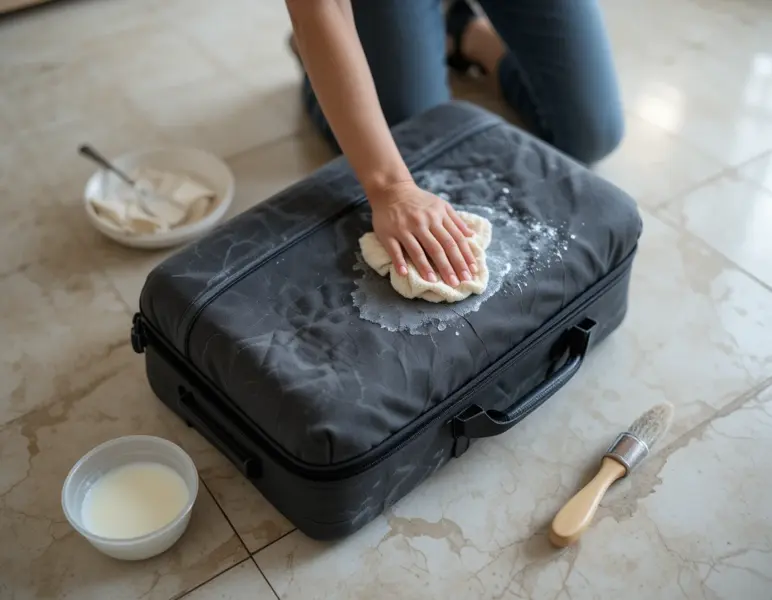
Frequently Asked Questions:
How do I clean a fabric suitcase without detergent?
You can often skip harsh detergents by using simple natural solutions. Mix equal parts water and white vinegar in a spray bottle and lightly mist the fabric lining or exterior spots. Vinegar disinfects and lifts dirt.
For stains, make a paste of baking soda and water, apply to the spot, let sit, then brush off. Even plain warm water with a soft brush can remove light dirt. The key is gentle scrubbing and plenty of rinsing: your goal is just to lift the grime without soaking the bag.
A refreshing finish is to air out the bag well, or leave an open box of baking soda inside to absorb any musty smell.
How to Clean Luggage Bag Stains?
First, identify the stain type. For greasy or oily marks, sprinkle baking soda on the stain and let it sit for 15–30 minutes; then brush or vacuum it away. For general stains (spilled coffee, ink, etc.), dab the area with a cloth moistened in warm water mixed with a little dish soap or laundry detergent.
For really stubborn marks, a solution of half rubbing alcohol and water (plus a squeeze of lemon juice) on a cloth can be effective. Always blot stains gently rather than rubbing hard (to avoid spreading). Avoid bleach or harsh solvents on most luggage, as those can discolor or weaken the material.
If the stain is on a hard-shell surface, a magic eraser sponge or a bit of non-gel toothpaste can sometimes lift scuffs without damage. Once treated, rinse the area with a damp cloth and let it air-dry.
How to Clean Luggage Bag Without Washing?
Absolutely. Many travelers prefer dry-cleaning methods. Start by vacuuming thoroughly inside and out to remove loose dirt and debris Then use disinfectant or all-purpose wipes on handles, zippers, and fabric surfaces for a quick cleanup.
A handy trick is to spray a mixture of water and rubbing alcohol (or diluted white vinegar) on a cloth and wipe down interior and exterior surfaces; this sanitizes without soaking. Finally, tackle odors by placing a bowl or sachet of baking soda (or activated charcoal) inside the bag while it sits open overnight. This absorbs smells naturally.
In short, you can refresh most of your suitcase with wiping, vacuuming, and odor absorbers without giving it a full bath – just be sure everything dries out completely before you pack.
Conclusion:
Cleaning your suitcase might seem like a chore, but it pays off in comfort and longevity. A clean bag protects your gear and even your health, ensuring you don’t reintroduce germs or odors into your routine. Plus, maintaining your luggage extends its lifetime so you aren’t replacing it too soon. After all, no one likes surprises when they unpack!
Next time you come home from a trip, remember: a little TLC goes a long way. Wipe it down, shake it out, and give it a good vacuum – your future self (and your next set of clothes) will thank you. Regular cleaning is truly the key to smoother travels and a well-traveled suitcase that stays fresh for many journeys ahead.

